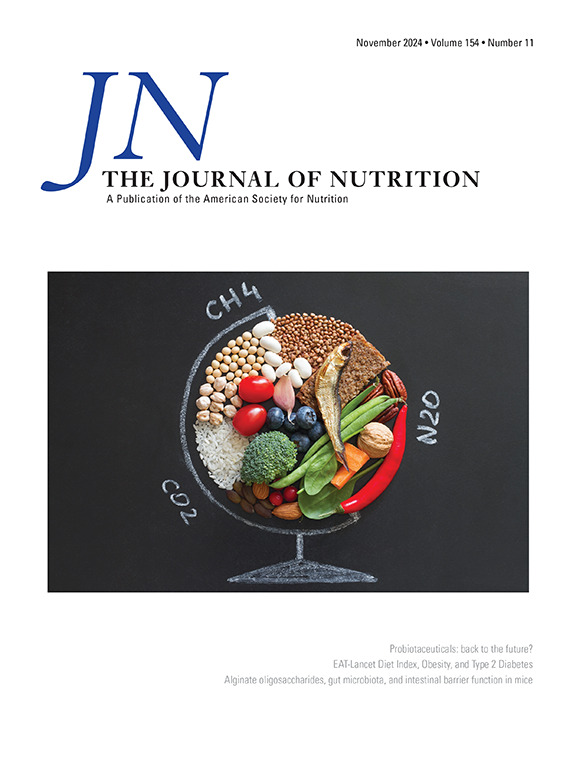Validation of the Latin American and Caribbean Food Security Scale (ELCSA) for use in Samoa
IF 3.7
3区 医学
Q2 NUTRITION & DIETETICS
引用次数: 0
Abstract
Background
Measuring food security accurately has implications for policies and programming designed to address both hunger and obesity risk among children.
Objectives
We aimed to examine the validity of the Latin American and Caribbean Food Security Scale (ELCSA) for use in Samoa.
Methods
The ELCSA was administered verbally to 454 Samoan mothers who were participants in an ongoing longitudinal cohort study (the Ola Tuputupua’e Study). Internal consistency and construct validity were examined with Rasch modeling, which generated item severity and item infit statistics. Associations between food security and several cohort characteristics including maternal education, household income, and child dietary intake were examined to determine whether common associations present in the extant literature could be replicated. Face and content validity were explored through focus group discussions with n = 34 of the participants.
Results
The ELCSA showed strong reliability and internal consistency and, with minor exceptions, participants clearly understood the survey questions. On the basis of Rasch modeling, the score thresholds for food insecurity used in the original tool are appropriate for use in Samoa. Many families in Samoa experience some degree of food insecurity, primarily driven by a lack of access to “healthy” foods, although extreme food insecurity was infrequent. The managed process of food insecurity is largely consistent with that found elsewhere, although uniquely protective factors such as continued subsistence farming and community food sharing mitigate the absolute lack of food for most families.
Conclusions
The Samoan translation of the 15-question ELCSA has validity for use among nonpregnant Samoan women with children. Although there are unique protective factors, food insecurity should be continuously monitored in Samoa with efforts made to provide resources to families experiencing extreme food insecurity.
确认在萨摩亚使用的拉丁美洲和加勒比粮食安全分级表。
背景:准确衡量粮食安全对旨在解决儿童饥饿和肥胖风险的政策和规划具有重要意义。目的:我们旨在检验拉丁美洲和加勒比粮食安全量表(ELSCA)在萨摩亚使用的有效性。方法:在一项正在进行的纵向队列研究(Ola Tuputupua'e研究)中,对454名萨摩亚母亲口头实施ELSCA。采用Rasch模型检验内部一致性和结构效度,生成项目严重性和项目不完整性统计。研究了食品安全与包括母亲教育、家庭收入和儿童膳食摄入在内的几个队列特征之间的关联,以确定现有文献中存在的共同关联是否可以复制。通过焦点小组讨论探讨面孔效度和内容效度,共有34名参与者。结果:ELSCA具有很强的信度和内部一致性,除了少数例外,参与者都清楚地理解了调查问题。根据Rasch模型,原始工具中使用的粮食不安全得分阈值适用于萨摩亚。萨摩亚的许多家庭都经历着某种程度的粮食不安全,主要原因是无法获得“健康”食品,尽管极端的粮食不安全并不常见。粮食不安全的管理过程与其他地方的情况基本一致,尽管持续的自给农业和社区粮食共享等独特的保护因素缓解了大多数家庭的绝对粮食短缺。结论:萨摩亚语翻译的15题ELSCA在有孩子的未怀孕的萨摩亚妇女中具有有效性。虽然存在着独特的保护因素,但应持续监测萨摩亚的粮食不安全状况,努力向遭受极端粮食不安全的家庭提供资源。
本文章由计算机程序翻译,如有差异,请以英文原文为准。
求助全文
约1分钟内获得全文
求助全文
来源期刊

Journal of Nutrition
医学-营养学
CiteScore
7.60
自引率
4.80%
发文量
260
审稿时长
39 days
期刊介绍:
The Journal of Nutrition (JN/J Nutr) publishes peer-reviewed original research papers covering all aspects of experimental nutrition in humans and other animal species; special articles such as reviews and biographies of prominent nutrition scientists; and issues, opinions, and commentaries on controversial issues in nutrition. Supplements are frequently published to provide extended discussion of topics of special interest.
 求助内容:
求助内容: 应助结果提醒方式:
应助结果提醒方式:


